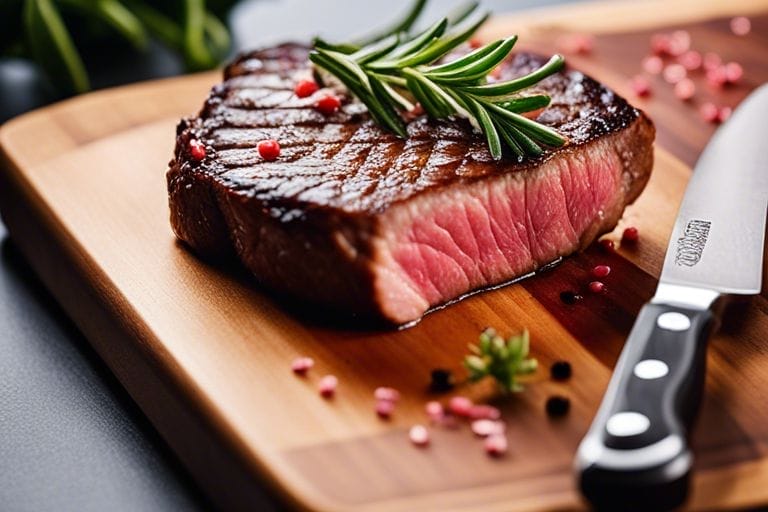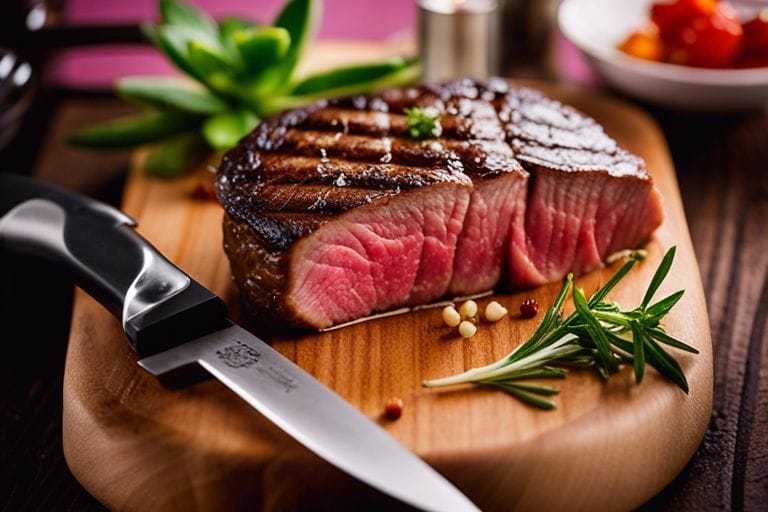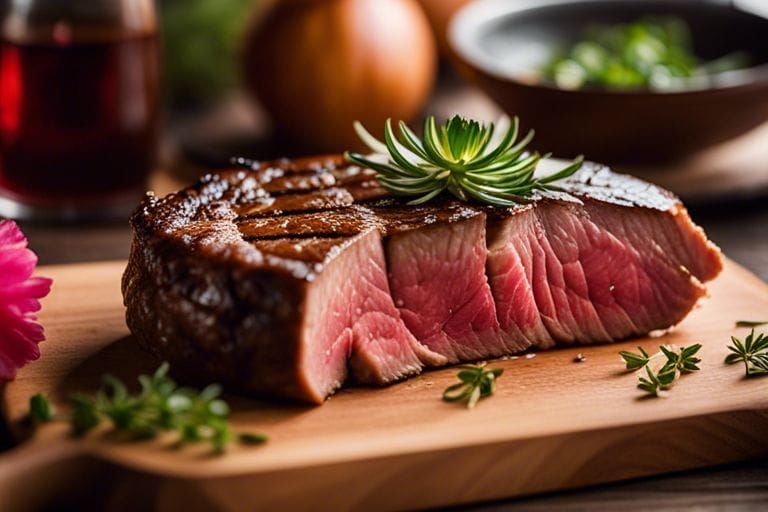Indulging in a perfectly cooked, medium-rare to medium steak can be a delightful experience. However, have you ever wondered if it is safe to consume meat that is not well-done? In this post, you will learn everything you need to know about cooking steak to perfection while ensuring it is safe to eat. From understanding the recommended cooking temperatures to minimizing health risks associated with consuming undercooked meat, mastering the art of cooking steak will allow you to enjoy a delicious meal without compromising on your well-being. Whether you prefer ribeye, sirloin, or filet mignon, knowing how to perfectly cook your steak will elevate your culinary skills and ensure a delicious and safe dining experience.
Key Takeaways:
- Medium-Cooked Steak is Safe: When cooked to an internal temperature of 140-145°F, a medium-cooked steak is safe to eat. This ensures that any harmful bacteria present in the meat are killed, while still maintaining a juicy and tender texture.
- Use a Meat Thermometer: To ensure that your steak reaches the proper temperature for medium cooking, use a meat thermometer to accurately gauge the internal temperature. This will help you avoid undercooking or overcooking the steak, resulting in a perfectly cooked and safe meal.
- Let it Rest: After cooking your steak, allow it to rest for a few minutes before slicing into it. This allows the juices to redistribute, resulting in a more flavorful and enjoyable eating experience.
The Safety of Medium-Cooked Steak
Assuming you’re a fan of steak, you may have heard warnings from friends or family members about the safety of ordering a medium-cooked steak at a restaurant. Some people believe that a medium-cooked steak poses a risk of foodborne illness and may have a negative impact on the taste and texture of the meat. Your dad may have even warned you to never order a steak cooked less than medium well. You can read more about this on Quora
Temperature and Bacterial Concerns
When it comes to the safety of medium-cooked steak, it’s important to understand the role of temperature in eliminating potential bacterial concerns. Cooking a steak to a medium level ensures that it reaches an internal temperature of at least 145°F (63°C), which is sufficient to kill off harmful bacteria such as E. coli and Salmonella. However, it’s crucial to note that the steak must be cooked evenly at this temperature throughout to ensure safety. For more information, refer to the following table:
| Temperature | Bacterial Concerns |
| 145°F (63°C) | Eliminates harmful bacteria |
| Average Medium Steak Temperature | Safe for consumption |
Myths vs. Facts on Steak Safety
There are several myths surrounding the safety of medium-cooked steak, but it’s important to differentiate fact from fiction. One common misconception is that a medium-cooked steak will have a disgusting taste or texture, but this isn’t necessarily true if the steak is prepared properly. The key is to ensure that the steak is cooked to the appropriate temperature to kill off any harmful bacteria while still preserving its flavor and juiciness. By following recommended cooking guidelines and using a reliable meat thermometer, you can enjoy a safe and delicious medium-cooked steak without any negative repercussions. For more information, refer to the following table:
| Myth | Fact |
| Medium-cooked steak is unsafe | Cooking to the appropriate temperature eliminates bacterial risks |
| Medium-cooked steak has a disgusting taste and texture | If prepared properly, it can be safe and delicious |
Cooking Techniques for the Perfect Medium Steak
Even the most experienced chefs will tell you that cooking the perfect medium steak is an art form. It requires precision, attention to detail, and an understanding of the different cooking techniques available to you. Here, we will walk you through the steps to achieve that beautiful, juicy medium steak that will leave your taste buds singing.
Choosing the Right Cut
When it comes to cooking the perfect medium steak, choosing the right cut of beef is crucial. Look for marbling throughout the meat, as this fat will melt as the steak cooks, adding flavor and juiciness. Ribeye, sirloin, and strip steaks are all great choices for achieving a tender, juicy medium steak. Remember, the thickness of the cut will also affect the cooking time, so keep that in mind when making your selection.
Seasoning and Cooking Methods
Seasoning your steak properly can make all the difference in achieving that perfect medium cook. A simple mix of salt and pepper is often all you need to bring out the natural flavor of the meat. When it comes to cooking methods, a combination of grilling and pan-searing can give you the best results. This will create a beautifully seared crust on the outside while keeping the inside juicy and tender. Remember to let your steak come to room temperature before cooking to ensure even cooking throughout.
Tools for Precision Cooking
When it comes to cooking the perfect medium steak, having the right tools can make all the difference. Invest in a good meat thermometer to ensure you cook your steak to the ideal temperature. This will help you avoid undercooking or overcooking your steak, and instead achieve that perfectly pink, juicy center. Additionally, having a quality pair of tongs and a cast-iron skillet can make the cooking process much easier and more precise.

Nutritional Considerations
After mastering the art of cooking a medium-cooked steak, it’s important to consider the nutritional aspects of your meal. You want to ensure that you are not only enjoying a delicious steak, but also reaping the nutritional benefits it has to offer. If you’re unsure about the doneness of your steak, refer to this temperature guide from rare to well-done to make sure your steak is cooked to your liking.
Health Benefits of Steak
Steak is a great source of protein, iron, zinc, and B vitamins. It provides important nutrients that contribute to overall health and wellbeing. Protein helps build and repair tissues, while iron is crucial for delivering oxygen to your cells. Zinc is essential for boosting your immune system, and B vitamins play a vital role in metabolism and energy production.
Considerations for Dietary Restrictions
If you have dietary restrictions, it’s important to be mindful of the type of steak you consume. While steak is a good source of nutrients, it can also be high in saturated fat. If you have high cholesterol or are at risk of heart disease, you may need to limit your intake of red meat. For those following a vegetarian or vegan diet, there are plenty of plant-based alternatives to steak that can provide similar nutritional benefits.

Enhancing Your Culinary Skills
Keep honing your culinary skills to become a master in the art of cooking. The key to perfecting your cooking techniques is to continually practice and experiment with different cooking methods and ingredients. Expand your knowledge of flavors, textures, and cooking techniques to elevate your culinary creations to the next level.
Troubleshooting Common Mistakes
When cooking medium-cooked steak, common mistakes can lead to less-than-desirable results. One major mistake is overcooking the steak, resulting in a dry and tough texture. To prevent this, make sure to use a reliable meat thermometer to accurately gauge the doneness of the steak. Another mistake is not allowing the steak to rest after cooking, which can cause the juices to escape, resulting in a dry steak. To avoid this, let the steak rest for a few minutes before slicing and serving.
Tips from Master Chefs
Learn from the experts to elevate your cooking skills. Master chefs emphasize the importance of using high-quality ingredients to enhance the flavor of your dishes. When cooking medium-cooked steak, choose prime cuts of meat for the best results. Additionally, season the steak generously with salt and pepper to bring out the natural flavors of the beef. Master chefs also recommend searing the steak on high heat to create a flavorful crust while locking in the juices. Perceiving the advice of master chefs can significantly improve your culinary skills and the quality of your dishes.
Is Medium-Cooked Steak Safe? Mastering Cooking Art
Following this guide, you now have a better understanding of how to safely prepare and cook medium-cooked steak. It’s important to remember that while medium-cooked steak can be safe to consume, it is crucial to pay attention to the quality of the meat and to use proper cooking techniques to minimize the risk of foodborne illness. By mastering the cooking art, you can confidently enjoy a perfectly cooked medium steak while ensuring the safety of your meal. Remember to always use a meat thermometer to check the internal temperature and follow the recommended guidelines for safe cooking practices. Enjoy your perfectly cooked steak with peace of mind!
FAQ
Q: Is it safe to eat medium-cooked steak?
A: Yes, it is safe to eat medium-cooked steak as long as the internal temperature of the steak reaches at least 145°F (63°C). At this temperature, harmful bacteria such as E. coli and Salmonella are killed, making the steak safe to consume. It is important to properly cook the steak to minimize any potential health risks.
Q: How can I ensure that my medium-cooked steak is safe to eat?
A: To ensure that your medium-cooked steak is safe to eat, use a meat thermometer to check the internal temperature. Insert the thermometer into the thickest part of the steak, avoiding any bones or fat. Once the steak reaches 145°F (63°C) or higher, it is safe to consume. Additionally, let the steak rest for a few minutes after cooking to allow the internal temperature to continue to rise and any remaining bacteria to be destroyed.
Q: Are there any risks associated with consuming medium-cooked steak?
A: While consuming medium-cooked steak can be safe when cooked properly, there are still some potential risks. Cross-contamination with other foods, improper storage of the steak, and consuming undercooked meat can all increase the risk of foodborne illness. It is important to handle and cook the steak with care to minimize these risks. Additionally, individuals with compromised immune systems, young children, and pregnant women should be mindful of consuming medium-cooked steak as they may be more susceptible to foodborne illnesses.

